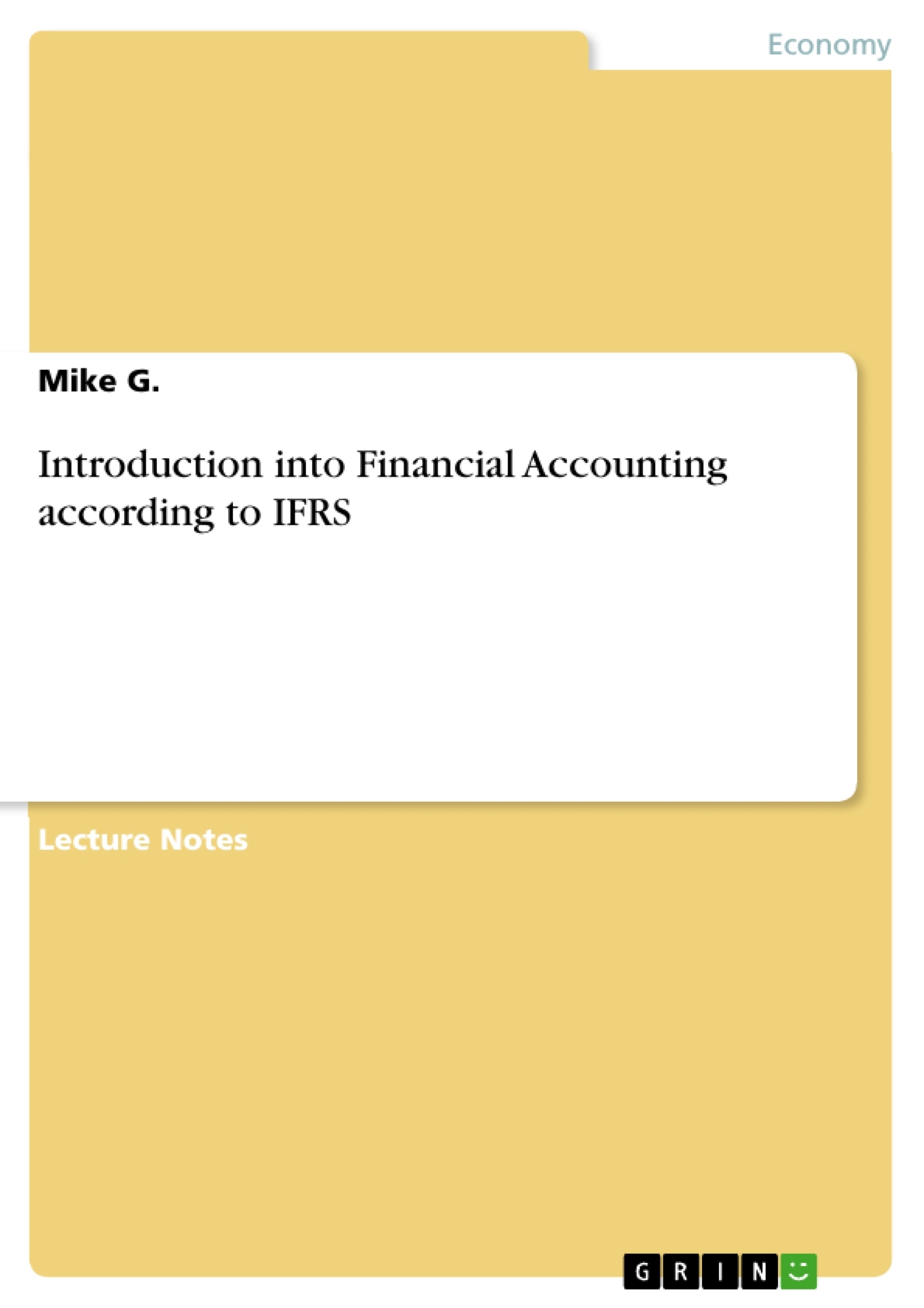The following text was created as part of the university module “Financial accounting according to IFRS standards”. This work will introduce the financial reporting procedure as well as the legal framework and enable the reader to create (simple) financial statements on his/her own. Several examples and numerical figures as well as visual displays support the understanding. At the end, there is a summary about the balance sheet adjustments and a kind of FAQ (as part of the exam preparation). Please be aware that the international approaches are very similar to the German ones, but are not always the same.
This work is made from the notes taken during lectures and supplemented by additional information and pictures from secondary literature, namely “Financial Accounting – International financial reporting standards”, published by Pearson and written by Walter T. Harrison Jr. and Charles T. Horngreen. Additionally, some information from this book was visually displayed in self-made figures, diagrams and compilations. If an image is not marked otherwise, it's self-created.
Inhaltsverzeichnis (Table of Contents)
- Basics
- Business Activities
- (1) Operating Activities
- (2) Investing Activities
- (3) Financing Activities
- Financial accounting statements
- (1) Statement of comprehensive income (I/S)
- (2) Statement of financial positions Balance Sheet (B/S)
- (3) Statement of cash flow (CF)
- (4) Statement of changes in Equity (AEq.)
- Structure of a balance sheet
- Components of retained earnings
- Structure of a cash flow statement
- Statement of changes in equity
- Why the financial statement is made
- Relevance vs. Reliability
- Organizing a business
- Transactions and Double-entry system
- What is a credit and a debit?
- How to prepare a balance sheet starting with blank sheet of paper
Zielsetzung und Themenschwerpunkte (Objectives and Key Themes)
This work aims to introduce the financial reporting procedure and its legal framework, enabling readers to create simple financial statements independently. It uses examples and visual aids to support understanding. The text also includes a summary of balance sheet adjustments and a FAQ section for exam preparation.
- Financial Reporting Procedures according to IFRS standards
- The Creation of Financial Statements (Balance Sheet, Income Statement, Cash Flow Statement)
- Legal Framework of Financial Accounting
- Analysis of Business Activities (Operating, Investing, and Financing)
- Understanding the Double-Entry Bookkeeping System
Zusammenfassung der Kapitel (Chapter Summaries)
Basics: This introductory chapter establishes the core concepts of financial accounting, highlighting the importance of comparable financial information and the role of accounting in communicating financial events and transactions. It emphasizes the various stakeholders interested in accurate and transparent financial accounting, including company management, employees, suppliers, the state, public, consumers, shareholders, creditors, and information intermediaries. The chapter also differentiates between financial and management accounting, contrasting their purposes, audiences, and characteristics.
Business Activities: This section details the three fundamental business activities: operating, investing, and financing. Operating activities describe the day-to-day processes of generating revenue through core business functions. Investing activities focus on the acquisition and disposal of assets to generate future returns. Finally, financing activities address the acquisition of financial resources through capital and debt instruments, such as stock exchange transactions. This foundational understanding of business activities is critical for correctly preparing financial statements.
Financial accounting statements: This chapter introduces the four primary financial statements: the statement of comprehensive income, the balance sheet, the statement of cash flows, and the statement of changes in equity. Each statement's purpose and the type of information it provides are clearly explained, emphasizing their interconnectedness. This section lays the groundwork for understanding how each statement contributes to a comprehensive view of a company's financial health.
Structure of a balance sheet: This section explains the structure and fundamental accounting equation of a balance sheet (Assets = Liabilities + Equity). It emphasizes the categorization of assets and liabilities, explaining their roles in providing a snapshot of a company’s financial position at a specific point in time. The importance of this structure in maintaining the balance between assets and funding sources is highlighted.
Components of retained earnings: This section describes how retained earnings are calculated within the context of the income statement and the statement of changes in equity. The explanation focuses on the impact of net income and dividends on the ending balance of retained earnings, illustrating the dynamic relationship between profitability and shareholder distributions.
Structure of a cash flow statement: This chapter details the structure and components of a statement of cash flows, categorized into operating, investing, and financing activities. It explains how this statement tracks the actual cash inflows and outflows of a company, offering crucial insights into its liquidity and financial stability. The chapter explains how to reconcile net income with net cash provided by operating activities, a key aspect of understanding cash flow.
Statement of changes in equity: This section elucidates the statement of changes in equity, explaining how it reveals changes in equity over a period. It details the components impacting equity, such as share capital issuance, net income, and cash dividends, thus providing a clear picture of changes in shareholder investment and company profitability.
Why the financial statement is made: This chapter clarifies the crucial role of financial statements in providing information for investor and creditor decision-making. It emphasizes the importance of decision usefulness, relevance, reliability, comparability, verifiability, timeliness, and understandability in financial reporting. The fundamental and enhancing characteristics of financial statements are thoroughly examined.
Relevance vs. Reliability: This section analyzes the crucial trade-off between relevance and reliability in financial reporting, balancing the need for timely, pertinent information with the requirement for accurate and unbiased representation. It introduces the three principles used to manage this balance: avoiding specific accounting treatments, increasing disclosure, and implementing control mechanisms (e.g., external audits).
Organizing a business: This chapter briefly outlines the three fundamental forms of business organizations: sole proprietorships, partnerships, and corporations, focusing on their liability structures. The text highlights that only corporations' financial statements are relevant for the exam scope.
Transactions and Double-entry system: This chapter introduces the double-entry bookkeeping system, explaining how transactions are recorded to maintain the balance between assets, liabilities, and equity. The concepts of debit and credit are explained in relation to their impact on the balance sheet accounts.
What is a credit and a debit? This section clarifies the meaning of debit and credit entries depending on the account type (assets, liabilities, or equity). It emphasizes the necessity of maintaining the fundamental accounting equation’s balance through equal debit and credit entries for every transaction.
How to prepare a balance sheet starting with a blank sheet of paper: This concluding chapter provides a step-by-step guide on the process of preparing a complete set of financial statements, starting from a list of transactions and proceeding through journal entries, T-accounts, the ledger, a trial balance, the income statement, retained earnings calculation, the statement of changes in equity, and finally, the balance sheet. This section synthesizes all previously introduced concepts into a practical workflow for financial statement preparation.
Schlüsselwörter (Keywords)
Financial accounting, IFRS standards, financial statements, balance sheet, income statement, statement of cash flows, statement of changes in equity, double-entry bookkeeping, assets, liabilities, equity, retained earnings, stakeholders, relevance, reliability, decision usefulness, business activities, operating activities, investing activities, financing activities.
Frequently Asked Questions: A Comprehensive Guide to Financial Reporting
What is this text about?
This text is a comprehensive guide to financial reporting procedures and the creation of financial statements. It covers the basics of financial accounting, the three main business activities (operating, investing, and financing), the four primary financial statements (income statement, balance sheet, cash flow statement, and statement of changes in equity), and the double-entry bookkeeping system. It also addresses the importance of relevance and reliability in financial reporting and provides a step-by-step guide to preparing a balance sheet.
What are the key objectives and themes of this text?
The main objective is to enable readers to independently create simple financial statements. Key themes include understanding IFRS standards, creating financial statements, the legal framework of financial accounting, analyzing business activities, and mastering the double-entry bookkeeping system. The text emphasizes practical application through examples and visual aids (not included in this HTML preview).
What are the main components of financial statements covered?
The text details the structure and purpose of the balance sheet (Assets = Liabilities + Equity), the income statement (Statement of Comprehensive Income), the statement of cash flows, and the statement of changes in equity. It explains how each statement contributes to a complete picture of a company's financial health and their interconnectedness.
What are the three fundamental business activities?
The three fundamental business activities are operating activities (day-to-day revenue generation), investing activities (acquisition and disposal of assets), and financing activities (acquiring financial resources through debt or equity).
What is the double-entry bookkeeping system?
The double-entry bookkeeping system is a method of recording financial transactions where each entry affects at least two accounts. This system ensures the accounting equation (Assets = Liabilities + Equity) remains balanced. The text explains debit and credit entries in detail.
What is the difference between debit and credit entries?
The meaning of debit and credit entries depends on the account type (asset, liability, or equity). Debits increase asset and expense accounts, while credits increase liability, equity, and revenue accounts. The text explains how these entries maintain the balance of the accounting equation.
How does the text explain the preparation of a balance sheet?
The text provides a step-by-step guide on preparing a complete set of financial statements, starting from a list of transactions and working through journal entries, T-accounts, the ledger, a trial balance, the income statement, retained earnings calculation, the statement of changes in equity, and finally, the balance sheet.
What is the importance of relevance and reliability in financial reporting?
The text highlights the crucial trade-off between relevance (timely and pertinent information) and reliability (accurate and unbiased representation) in financial reporting. It discusses how this balance is managed using principles such as avoiding specific accounting treatments, increasing disclosure, and implementing control mechanisms (like external audits).
Who are the stakeholders interested in financial accounting?
Stakeholders interested in accurate and transparent financial accounting include company management, employees, suppliers, the state, the public, consumers, shareholders, creditors, and information intermediaries.
What is the difference between financial and management accounting?
While the text doesn't explicitly detail the differences, it implicitly contrasts them by emphasizing that this text focuses on financial accounting (external reporting) and its requirements, implying differences in purpose, audience, and characteristics compared to management accounting (internal use).
What types of business organizations are mentioned?
The text mentions sole proprietorships, partnerships, and corporations, but emphasizes that only corporations' financial statements are relevant for the exam scope implied within the text.
- Quote paper
- Mike G. (Author), 2016, Introduction into Financial Accounting according to IFRS, Munich, GRIN Verlag, https://www.grin.com/document/351180




